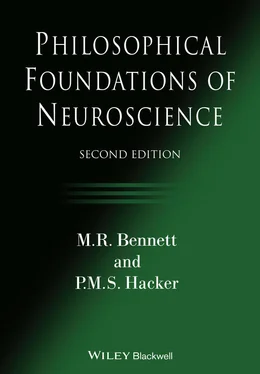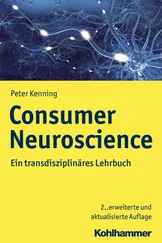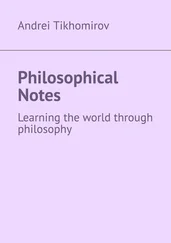All rights reserved. No part of this publication may be reproduced, stored in a retrieval system, or transmitted, in any form or by any means, electronic, mechanical, photocopying, recording or otherwise, except as permitted by law. Advice on how to obtain permission to reuse material from this title is available at http://www.wiley.com/go/permissions.
The right of M.R. Bennett and P.M.S. Hacker, to be identified as the authors of this work has been asserted in accordance with law.
Registered Offices
John Wiley & Sons, Inc., 111 River Street, Hoboken, NJ 07030, USA
John Wiley & Sons Ltd, The Atrium, Southern Gate, Chichester, West Sussex, PO19 8SQ, UK
Editorial Office
111 River Street, Hoboken, NJ 07030, USA
For details of our global editorial offices, customer services, and more information about Wiley products visit us at www.wiley.com.
Wiley also publishes its books in a variety of electronic formats and by print-on-demand. Some content that appears in standard print versions of this book may not be available in other formats.
Limit of Liability/Disclaimer of Warranty
The contents of this work are intended to further general scientific research, understanding, and discussion only and are not intended and should not be relied upon as recommending or promoting scientific method, diagnosis, or treatment by physicians for any particular patient. In view of ongoing research, equipment modifications, changes in governmental regulations, and the constant flow of information relating to the use of medicines, equipment, and devices, the reader is urged to review and evaluate the information provided in the package insert or instructions for each medicine, equipment, or device for, among other things, any changes in the instructions or indication of usage and for added warnings and precautions. While the publisher and authors have used their best efforts in preparing this work, they make no representations or warranties with respect to the accuracy or completeness of the contents of this work and specifically disclaim all warranties, including without limitation any implied warranties of merchantability or fitness for a particular purpose. No warranty may be created or extended by sales representatives, written sales materials or promotional statements for this work. The fact that an organization, website, or product is referred to in this work as a citation and/or potential source of further information does not mean that the publisher and authors endorse the information or services the organization, website, or product may provide or recommendations it may make. This work is sold with the understanding that the publisher is not engaged in rendering professional services. The advice and strategies contained herein may not be suitable for your situation. You should consult with a specialist where appropriate. Further, readers should be aware that websites listed in this work may have changed or disappeared between when this work was written and when it is read. Neither the publisher nor authors shall be liable for any loss of profit or any other commercial damages, including but not limited to special, incidental, consequential, or other damages.
Library of Congress Cataloging-in-Publication Data
Names: Bennett, M. R., author. | Hacker, P. M. S. (Peter Michael Stephan), author.
Title: Philosophical foundations of neuroscience / M.R. Bennett and P.M.S. Hacker.
Description: Second Edition. | Hoboken, New Jersey: John Wiley & Sons, 2022. |
First Edition: 2003. | Includes bibliographical references and index.
Identifiers: LCCN 2021008649 | ISBN 9781119530978 (Paperback) | ISBN 9781119531012 (PDF) | ISBN 9781119530633 (ePub) | ISBN 9781119530923 (eBook)
Subjects: LCSH: Cognitive neuroscience--Philosophy.
Classification: LCC QP360.5 .B465 2022 | DDC 612.8/233--dc23 LC record available at https://lccn.loc.gov/2021008649
Cover design by Wiley
Set in 10/12pt BemboSTD by Integra Software Services Pvt. Ltd, Pondicherry, India
For Gillian and Jocelyn
1 Cover
2 Reviews of Philosophical Foundations of Neuroscience
3 Title page
4 Copyright
5 Dedication
6 Foreword to the Second Edition by Denis Noble
7 Foreword to the First Edition by Denis Noble
8 Acknowledgements to the Second Edition
9 Acknowledgements to the First Edition
10 Introduction to the First Edition
11 Introduction to the Second Edition
12 Part I Philosophical Problems in Neuroscience: Their Historical and Conceptual RootsPreliminaries to Part I1 Philosophical Problems in Neuroscience: Their Historical Roots2 Philosophical Problems in Neuroscience: Their Conceptual Roots 1 The Growth of Neuroscientific Knowledge: The Integrative Action of the Nervous System1.1 Aristotle, Galen and Nemesius: The Origins of the Ventricular Doctrine1.2 Fernel and Descartes: The Demise of the Ventricular Doctrine1.3 The Cortical Doctrine of Willis and Its Aftermath1.4 The Concept of a Reflex: Bell, Magendie and Marshall Hall1.5 Localizing Function in the Cortex: Broca, Fritsch and Hitzig1.6 The Integrative Action of the Nervous System: Sherrington1.6.1 The dependence of psychological capacities on the functioning of cortex: localization determined non-invasively by Ogawa and Sokolof1.6.2 Caveats concerning the use of fMRI to determine the areas of cortex involved in supporting psychological powers 2 The Growth of Neuroscientific Knowledge: The Integrative Action of the Nervous System2.1 Charles Sherrington: The Continuing Cartesian Impact2.2 Edgar Adrian: Hesitant Cartesianism2.3 John Eccles and the ‘Liaison Brain’2.4 Wilder Penfield and the ‘Highest Brain Mechanism’ 3 The Mereological Fallacy in Neuroscience3.1 Mereological Confusions in Cognitive Neuroscience3.2 Challenging the Consensus: The Brain Is Not the Subject of Psychological Attributes3.3 Qualms Concerning Ascription of a Mereological Fallacy to Neuroscience3.4 Replies to Objections 4 An Overview of the Conceptual Field of Cognitive Neuroscience: Evidence, the Inner, Introspection, Privileged Access, Privacy and Subjectivity4.1 On the Grounds for Ascribing Psychological Predicates to a Being4.2 On the Grounds for Misascribing Psychological Predicates to an Inner Entity4.3 The Inner4.4 Introspection4.5 Privileged Access: Direct and Indirect4.6 Privacy or Subjectivity4.7 The Meaning of Psychological Predicates: How They Are Explained and Learned4.8 Of the Mind and Its Nature
13 Part II Human Faculties and Contemporary Neuroscience: An AnalysisPreliminaries to Part II1 Brain–Body Dualism (Searle)2 The Project3 The Category of the Psychological 5 Sensation and Perception5.1 Sensation5.2 Perception5.2.1 Perception as the causation of sensations: primary and secondary qualities5.2.2 Perception as hypothesis formation: Helmholtz5.2.3 Visual images and the binding problem5.2.4 Perception as information processing: Marr’ s theory of vision 6 The Cognitive Powers6.1 Knowledge and Its Kinship with Ability6.1.2 Possessing knowledge and containing knowledge6.2 Memory6.2.1 Declarative and non-declarative memory6.2.2 Storage, retention and memory traces 7 The Cogitative Powers7.1 Belief7.2 Thinking7.3 Imagination and Mental Images7.3.1 The logical features of mental imagery 8 Emotion8.1 Affections8.2 The Emotions: A Preliminary Analytical Survey8.2.1 Neuroscientists’ confusions8.2.2 Analysis of the emotions 9 Volition and Voluntary Movement9.1 Volition9.2 Libet’s Theory of Voluntary Movement and Its Progeny9.3 Refutations and Clarifications9.4 Conflict-Monitoring and the Executive9.5 Man and Machine: Doing Something Like an Automaton, Automatically, Mechanically, from Force of Habit9.6 Taking Stock
14 Part III Consciousness and Contemporary Neuroscience: An Analysis 10 Intransitive and Transitive Consciousness10.1 Consciousness and the Brain10.2 Intransitive Consciousness and Awareness10.2.1 Minimal states of consciousness or responsiveness10.3 Transitive Consciousness and Its Forms10.3.1 A partial analysis 11 Conscious Experience, Mental States and Qualia, Neural Correlates of Consciousness11.1 Extending the Concept of Consciousness11.2 Conscious Experience and Conscious Mental States11.2.1 Confusions regarding unconscious belief and unconscious activities of the brain11.3 Qualia11.3.1 ‘How it feels’ to have an experience11.3.2 Of there being something which it is like …11.3.3 The qualitative character of experience11.3.4 Thises and thuses11.3.5 Of the communicability and describability of qualia 12 Neural Correlates of Consciousness, Integrated Information Theory, Global Workspace Theory12.1 The Integrated Information Theory of Tononi12.1.1 Axiomatizing Integrated Information Theory12.1.2 The ambiguity of ‘information’12.1.3 Unclarities about experience again12.2 Global Workspace Theory12.2.1 Analysis of Dehaene’s example12.2.2 On Dehaene’s misconceptions of consciousness and information processing12.3 On Finding One’s Way through a Conceptual Jungle with Worthless Tools12.4 What Is Necessary for Neural Correlation12.5 Where to Find the Explanations 13 Puzzles about Consciousness13.1 A Budget of Puzzles13.2 On Reconciling Consciousness or Subjectivity with Our Conception of an Objective Reality13.3 On the Question of How Physical Processes Can Give Rise to Conscious Experience13.4 Of the Evolutionary Value of Consciousness13.5 The Problem of Awareness13.6 Other Minds and Other Animals 14 Self-Consciousness and Selves, Thought and Language14.1 Self-Consciousness and the Self14.2 Historical Stage Setting: Descartes, Locke, Hume and James14.3 Current Scientific and Neuroscientific Reflections on the Nature of Self-Consciousness14.4 The Illusion of a ‘Self’14.5 The Horizon of Thought, Will and Affection14.5.1 Thought and language14.6 Self-Consciousness 15 Concepts, Thinking and Speaking15.1 Concepts and Concept Possession15.1.1 Beginning again15.2 Concept Possession as Mastery of the Use of an Expression15.3 What Do We Think In?
Читать дальше












